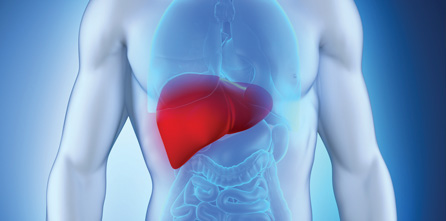
Cirrhosis of the liver is a serious chronic liver disease. It results in the destruction (necrosis) of liver cells, cousing scar tissue (fibrosis) to replace a large part of normal liver tissue. The consequence is poor liver function.
The condition can be caused by several factors, with the most frequent being excessive alcohol consumption, chronic viral hepatitis C or B, hemochromatosis (a hereditary disease caused by having too much iron in the body) and fatty liver disease (FLD), caused by an accumulation of fat in liver cells via the process of steatosis. Other less common causes are autoimmune conditions, certain meedicines, etc. in all types of liver disease, it is extremely important to give the correct treatment as early as possible to prevent it from advancing and turning into cirrhosis. Cirrhosis is usually irreversible, but sometimes, if a highly effective treatment is administered in time, such as for chronic hepatitis B, it can be cured.
It is diagnosed by means of a liver biopsy, although it is much easier to obtain a diagnosis via Fibroscan (EchosensTM). Fibroscan is a simple, painless test that involves no risk and measures liver fibrosis. In more serious cases of liver cirrhosis, the combination of symptoms plus analytical results and X-rays can also serve to diagnose the condition.
Cirrhosis must be taken seriously because it indicates an advanced stage of chronic liver disease.
It is a frequent condition and can have serious consequences for people suffering from it. It is the 8th most common cause of death in Spain.
Cirrhosis can lead to a further two complications, portal hypertension (which causes ascites or accumulation of liquid in the abdomen, bleeding from oesophageal varices, hepatic encephalopathy or confused mental state) and liver cancer.
The disease can produce a series of typical disorders when complications arise (ascites, bleeding from varices, jaundice or yellowish skin, etc.). However, it can often produce mild symptons (tiredness, lack of appetite, weight loss, etc.).
The possibilityof cirrhosis should be considered in the following cases:
- Patients with a history of alcohol abuse.
- Patients with chronic viral hepatitis C or B.
- People with a chronically high level of transaminase enzymes (AST or SGOT and ALAT or SGPT) or abnormalities in other liver analytical results.
- Subjects with analytical data showing an accumulation of iron in their bodies.
- Patients with chronic liver disorders that show up in abdominal ultrasound or X-rays (CAT, magnetic resonance).
- Patients with oesophageal varices.
Early diagnosis of liver cirrhosis is crucial for treating its cause, carrying out the necessary tests (analyses, ultrasound, etc.) and preventing the appearance of complications. Once cirrhosis of the liver has been diagnosed, the patient should be monitored for life.
Dr. Mariano Gómez Rubio – Hepatologist.
The information published in this media neither substitutes nor complements in any way the direct supervision of a doctor, his diagnosis or the treatment that he may prescribe. It should also not be used for self-diagnosis.
The exclusive responsibility for the use of this service lies with the reader.
ASSSA advises you to always consult your doctor about any issue concerning your health.












